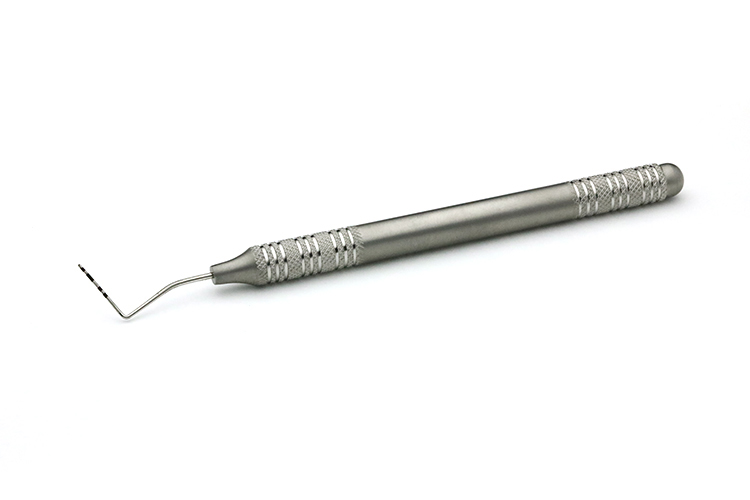Using a Periodontal Probe to Measure Tissue Depth
The periodontal probe or tissue probe is one of the most commonly used instruments in dentistry. Designed to examine and determine the space between gum tissue and the tooth, a periodontal probe can inform clinicians of gum health and helps to guide any necessary dental procedures.
The right technique is essential for getting the best results from a periodontal probe. Learn how to use a periodontal probe to measure tissue depth and order the most reliable tissue probes and a full range of instruments from Dental Implant Technologies.
Steps for Using a Periodontal Probe
The steps for using a periodontal probe are straightforward to follow. Clinicians learn techniques for tissue probes early in their education, but it’s helpful to review the steps whenever purchasing new instruments for the dental office.
Tissue probe method:
- Insert the tip of the periodontal probe underneath the gingival margin, adjacent to the tooth. Use gentle and consistent pressure. Probes are typically gripped like pens using a forefinger as a fulcrum. The grip is important when using a periodontal probe. It should be firm enough to maintain control but relaxed enough that resistance can be felt.
- Avoid probing with too much pressure or too quickly. This can cause a puncture in the pocket, which is painful for the patient. Probing too quickly also causes inaccurate measurement, which can compromise how treatments are planned.
- The tip of the probe should be parallel to the long axis of the tooth. Never use a probe at an angle. This is not only potentially dangerous but also compromises the accuracy of the measurement.
- Obstruction sometimes occurs when the probe connects with a calculus ledge. This can be worked around by moving the probe towards the tissue wall.
- The bottom of the gingival pocket is reached when there is slight resistance felt at the bottom. Dental clinicians compare this soft resistance to that of a rubber band.
These steps will provide the first measurement, but the process isn’t complete. Measurements are taken at several positions on each tooth to ensure the most consistent probe result.
A process of “walking” is used to take several measurements without removing the probe from the sulcus.
Walking is simply the process of moving the probe up and down in short bobbing or hopping strokes. It should be moved in 1mm increments to take up to six measurements during the procedure. The probe tip should always be parallel to and connected with the tooth surface while taking each measurement.
What are the Normal Measurements Indicated by a Tissue Probe?
Depending on gum health and the presence of disease, the pocket measured can range from 1mm to 10mm.
- In normal cases, there should be between 1mm and 3mm of space below the gum tissue. This is considered healthy and indicates that there is no gum disease present.
- Early periodontitis usually presents with 3mm to 5mm of space below the gum tissue.
- Moderate periodontitis presents with 5mm to 7mm below the gum tissue.
- The most advanced cases of periodontitis typically present with 7mm to 10mm of space below the gum tissue.
Tissue probes allow clinicians to determine gum health quickly and effectively. This is important during dental examinations, when diagnosing gum disease, and when preparing patients for implant treatment.
The Best Instruments for Periodontal Probing
Reliable periodontal probes make the process easier. They ensure comfortable handling and accurate measurements of the pocket.
- The UNC15 Probe (SKU: NX-UNC15) is a general-purpose periodontal probe with depth marking in 1mm increments. This probe is unique in how it has markings from 1mm to 15mm, giving it more potential for depth measurement when compared to other probes. Some of the most advanced cases of periodontitis can present pockets with depth below 10mm, the UNC15 Probe is the best choice for periodontists who routinely treat patients with advanced gum disease and decay.
- General Dentists performing routine examinations and providing treatment planning don’t always need a probe with extended depth. The Williams Michigan Probe (SKU: NX-MICHP) has depth indicators at common increments including 1mm, 2mm, 3mm, 5mm, 7mm, 8mm, 9mm, and 10mm. These increments allow a clinician to easily determine gum health.
Both instruments have angulated heads to ensure ease of handling and access to any position of the mouth.
Order Periodontal Probes from Dental Implant Technologies
We stock a complete range of periodontal probes for any clinical scenario. Browse all of our probes and explorers to find the perfect solution for your needs. We supply clinicians throughout the United States and offer cost-efficient pricing on the highest quality dental instruments.



